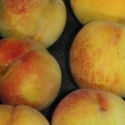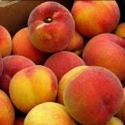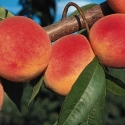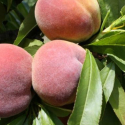Peach




Just the word “Peach” creates associations that make the mouth water! And the word “Peachy” makes one think of something beautiful, soft, and fragrant. And then there is the colour; a soft, warm, pastel shade that is reminiscent of the flesh of the fruit rather than the blossom. A tree well worth growing for its delectable fruit, the Peach is also a truly beautiful flowering specimen, with its blossoms bursting into ‘pinkness’ in the early spring. And, being a deciduous tree, it will also produce beautiful autumn foliage after the fruiting is over. This is a good specimen to shape into an Espalier form.
READ MORE
Peaches like moist, well drained soil with some protection from strong wind for the spring blossom. Keep the ground around the base of the trees free of weeds and feed young trees with good quality organic compost. Peaches should be located in a position with good air flow. This allows cold air to flow away on frosty nights and keeps the area cool in summer. Peaches are best planted in early winter, as this allows time for the roots to establish and be able to sustain the new spring growth. For optimum growth, peach trees require a constant suply of water. This should be increased shortly before the harvest. The best tasting fruit is produced when the peach is watered throughout the season. Drip irrigation is ideal, at least one driper per tree.
Most of the peach trees we stock are named cultivars grafted onto a suitable rootstock. It is possible to grow a tree from either a peach or nectarine seed, but the fruit quality of the resulting tree will be very unpredictable. Peaches have a high nutrient requirement, needing more nitrogen than most other fruit trees. A mulch of poultry manure in autumn soon after the harvest will benefit the tree.
If the leaves of the peach are yellow or small, the tree needs more nitrogen. Blood meal and bone meal are suitable fertilizers - and don’t forget lashings of luscious compost.Tips for good fruit: If the full amount of peaches remain on the tree, they will be under-sized and lacking in flavour. The fruit should be thinned when they have reached 2 cm in diameter, usually about 2 months after flowering. Fresh fruit is best consumed on the day of picking, as they do not keep well. They are best eaten when the fruit is slightly soft, having an aroma, and heated by the sun.
Cultivated peaches are divided into "freestone" and "clingstone" cultivars, depending on whether the flesh sticks to the stone or not; both kinds can have either white or yellow flesh. Peaches with white flesh typically are very sweet with little acidity, while yellow-fleshed peaches typically have an acidic tang coupled with sweetness, though this also varies greatly. Both colours often have some red on their skin. Apart from eating them sun-ripened off the tree, or slightly chilled with fresh cream, there are some fabulous recipes that use peaches, such as smoothies, fruit salads, the great Peach Island Sunset drink, peach and plum gratin, fruit kebabs, peach-teriyaki grilled chicken, buttermilk and peach muffins and many, many more mouthwatering munchies.
READ LESS
Find out more at How to Grow Peaches
0 LISTINGS FOR PEACH
PAGE 1 ALL HL Nurseries Limited t/a Wairere Nursery0 LISTINGS FOR PEACH
826 Gordonton Road, R D 1, Hamilton 3281 Ph: (07) 824 3430 Email: